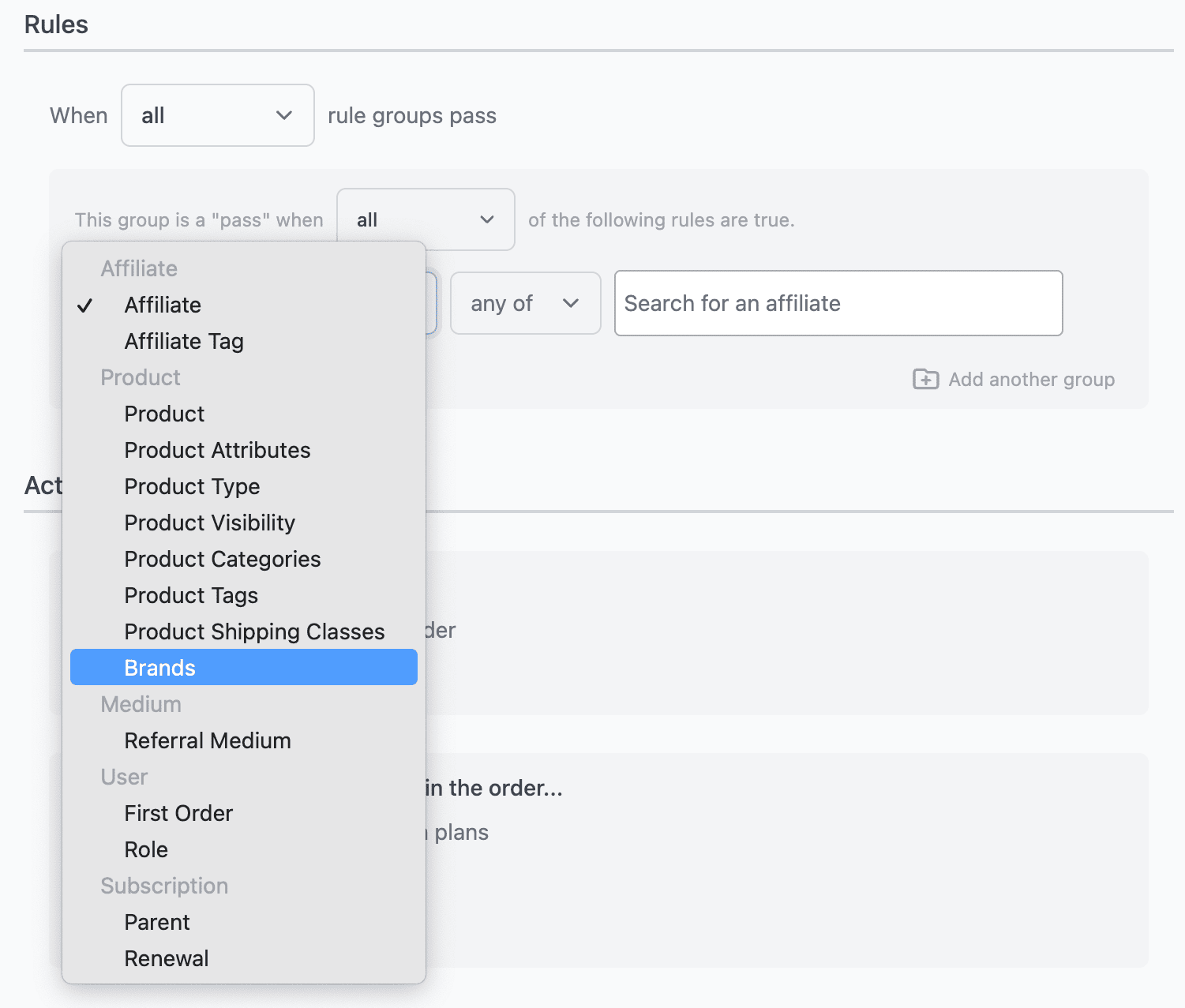Are you paying the right commissions to your affiliates?
Let’s say you sell different types of shoes — sports shoes, luxury leather shoes, and budget-friendly sneakers. Would you offer the same commission on all of them?
Probably not. A flat commission structure might work in some cases, but it doesn’t account for factors such as profit margins, shipping costs, or product demand.
For example, you want to offer higher commissions on premium organic food than the rest of the items.
Or maybe you want to incentivize affiliates to promote Nike shoes during mega sports events.
This is where product taxonomy commission step in.
With this new feature update in Affiliate for WooCommerce, you can now fine-tune commission rates based on different product taxonomies like product attributes, brands, type, visibility, shipping classes, and more.
Let’s explore how this can transform your affiliate strategy.
Setting up commission plans based on product taxonomy
A well-structured commission plan is the key to a successful affiliate program.
And Affiliate for WooCommerce helps you do exactly that. It offers complete flexibility to set commissions based on product taxonomy, affiliate, subscriptions and more.

Apart from this, it also helps you to:
- Automatically apply commission rules across your store, saving time and ensuring consistency.
- Track affiliate performance with real-time metrics like clicks, conversions, and sales.
- Pay affiliates via PayPal, Stripe, or manual methods, with customizable payout thresholds.
- Access detailed reports on affiliate activity, sales, and commissions.
- Provide affiliates with personalized links, banners, and marketing materials.
And so many more.
Now, you may already be familiar with product & category-based commissions, let’s explore additional product taxonomies and how you can use them to create smarter commission plans.
Product attributes
Product attributes define the characteristics of a product, such as size, color, material, or brand.
But how does this translate into commissions?
Let’s say you run an online clothing store. Now, instead of offering the same commission across all products, you can set higher commissions for eco-friendly fabrics like organic cotton and lower commissions for synthetic materials
This way, you can incentivize affiliates to promote sustainable fashion and align with customer preferences and business goals.
Product type
In WooCommerce, products can have different types — simple, variable, grouped, external, or subscription-based.
With product type-based commissions, you can set different rates based on these classifications.
For example, if you sell both one-time purchase software and subscription-based tools, you can offer a higher commission on subscriptions to encourage affiliates to promote recurring revenue products.
With product tag-based commissions, you can assign different rates to products grouped under a common tag.
For example, say you run a fashion store and tag certain products as “fresh arrivals”. You can offer higher commissions on these seasonal items to encourage affiliates to promote them more.
Product shipping classes
Shipping classes help group products based on their shipping requirements — like bulky items, fragile goods, or express shipping products.
With this, you can set different commission rates based on shipping costs.
For example, say you sell furniture and have a “Heavy shipping” class for large items like sofas and wardrobes. Since shipping costs are high, you might offer a lower commission on these products to balance expenses.
On the other hand, for lightweight accessories, you can offer high commissions for increased sales.
Brands
With brand based commissions, you can set higher commissions for premium brands and drive more sales.
For example, if you sell both Levi’s and other local clothes brands in your store, you can offer higher commission on Levi’s for higher profits.
Product visibility
Not all products in your store are equally visible. Some may be featured, hidden, or available only in search or category pages.
With product visibility-based commissions, you can adjust affiliate rewards based on how a product is displayed.
For example, say you have a featured section highlighting your best-selling gadgets. You can offer higher commissions on these products to boost their promotion.
On the other hand, if you have limited-stock or exclusive items that are hidden from the main catalog, you can set lower commissions or restrict promotions to select affiliates.
Custom taxonomies
Now, these are some known taxonomies, but what about others? Well, there can be infinite taxonomies based on your business.
With Affiliate for WooCommerce, you have the flexibility to provide any custom product taxonomy commission. Whether you use default product attributes, brand names, or custom taxonomies from third-party plugins, you can tailor commission structures to fit your business needs.
For example:
- Seasonal collection: If you organize products into collections like Summer wear, Winter essentials, or Festival specials, you can set specific commission rates for them.
- Material-based: If your store sells products based on material, such as cotton, leather, or recycled plastic, you can set different commissions based on their cost and demand.
Overall, by using these product taxonomy-based commissions, you can reward affiliates strategically and stay aligned with your profit margins and sales goals.
Next, let’s see how to set it up.
Steps to set up Brand-based product taxonomy commission
Let’s say you run a shoe store. You want to sell more Nike shoes and make more profit. So, you need to create a commission plan to offer specific affiliate a higher commission for that brand and category.
Make sure first, you have created the Brand taxonomy. Refer steps on how to set up taxonomies.
Now the steps to create commission plan:
- Install and activate the Affiliate for WooCommerce plugin.
- Navigate to
WooCommerce > Affiliates > Plans. - Click
Add a Planand name it. For example, ‘Commission on Nike Shoes’. - Choose
percentage-basedand set the rate (30%). - Under the
Rulessection, click on the dropdown and:- Select
Affiliate > any of > Kate. - Select
Brands > any of > Nike. - Select
Product Categories > any of > Shoes.
- Select
- Next, decide what commission should apply to other products in the order if any.
- Set the plan status to
Activeand save your changes.

And you are done.
Conclusion
With product taxonomy commission, you’re no longer stuck with a one-size-fits-all approach.
You get the flexibility to reward affiliates strategically — whether it’s pushing high-margin products, balancing shipping costs, or boosting seasonal sales.
And the best part? Affiliate for WooCommerce makes it super simple to set up.
So, why leave money on the table? Start using product taxonomy-based commissions and make your affiliate program work for you.
